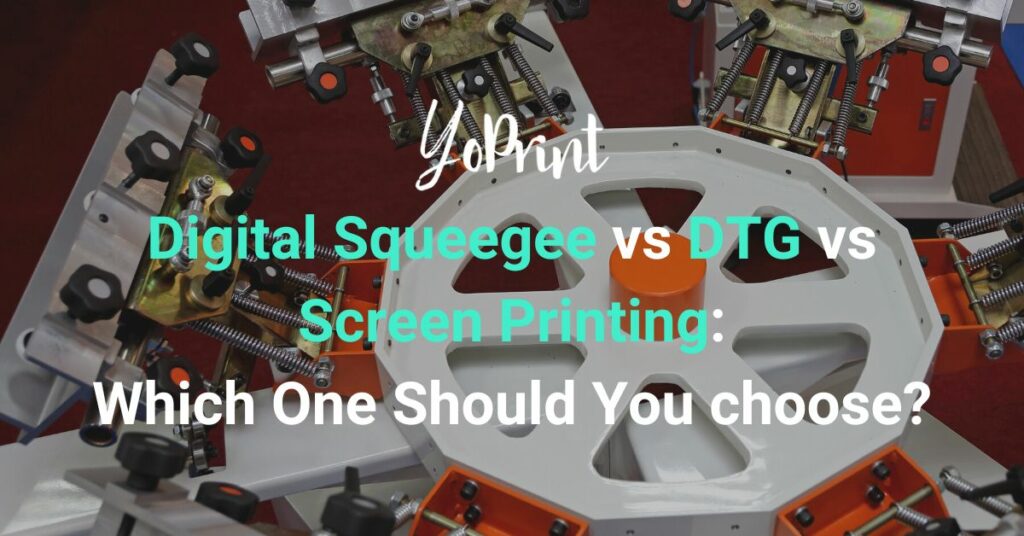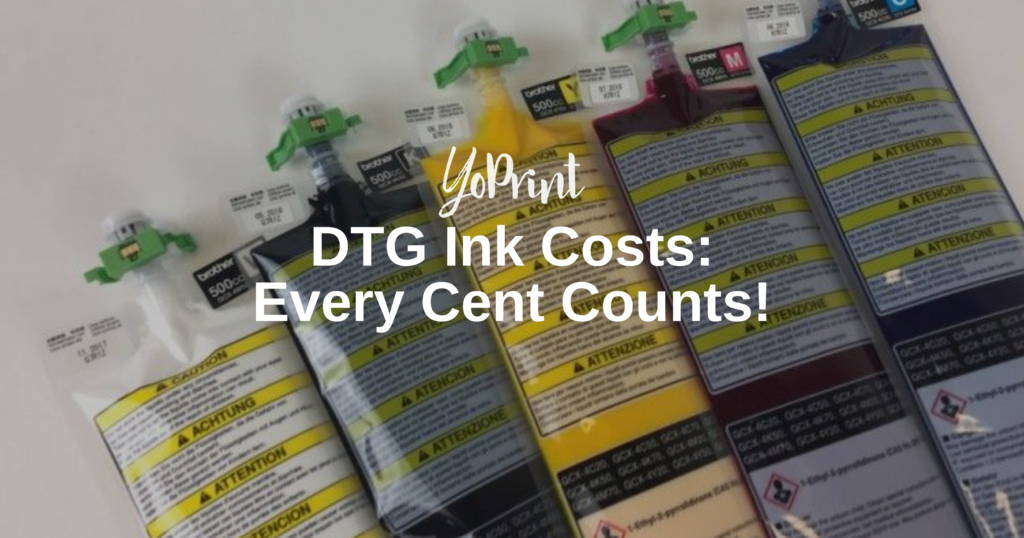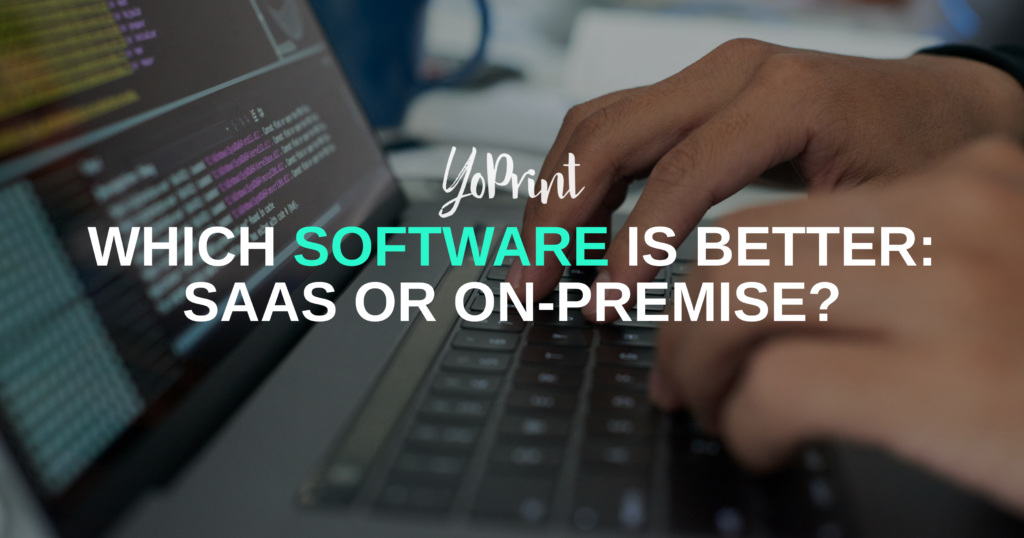Screen printing and direct-to-garment (DTG) printing are two of the industry’s most popular garment printing methods. Each method presents different advantages and disadvantages to users, but what if it were possible to combine the best of both approaches into a single system?
Digital hybrid systems are slowly being introduced to the industry, combining screen printing and DTG’s advantages into one powerful package. Hybrid systems are a significant disruptor, offering greater flexibility to industry players intending to make the switch.
With a third option now available from various manufacturers, there’s a lot of talk about how these hybrid systems can revolutionize the industry. But what makes these hybrid printers so unique? Let’s take a deep dive into this groundbreaking technology.
So What is Screen Printing?
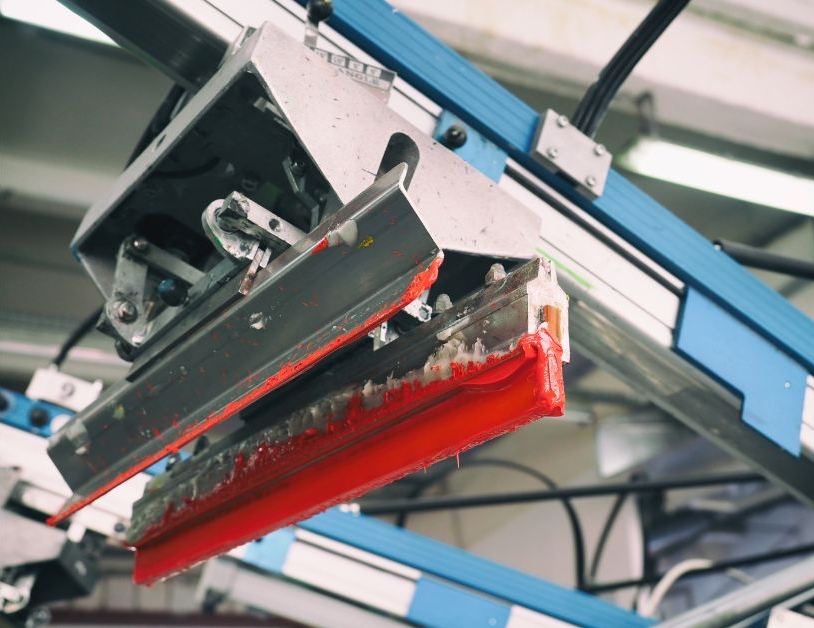
Let’s start with screen printing, the most widely known and used printing method with a rich history dating back thousands of years across many cultures.
The process involves transferring ink to a mesh screen, with a design stenciled onto it to allow the ink to pass. The ink is then transferred onto the surface of a garment. Once done, the garment is cured (or heated) so the ink properly sets into the garment.
Advantages of Screen Printing
Low Entry & Maintenance Costs: Entry-level printers can range from $400 to $3,000. Screen printing inks are also very affordable in contrast to DTG printing. Once you’ve set up your shop layout, you’ll be able to start printing in no time. You can even do it from your garage (although we don’t recommend this)!
Versatility: Though it’s pretty labor-intensive, you’ll be able to produce a considerable number of printed products in a relatively modest time while using the proper techniques to improve productivity.
Not only will you be able to print on cotton garments, but you can also print on a wide array of materials – from polyesters to glass and even metal surfaces. You’ll be able to cater to the needs of a highly varied customer base!
Printing Speeds: With a proper setup, you can easily print around 40 to 100 shirts in an hour with a manual printing press. An automatic press can easily ramp up to 400 to 800 prints per hour. This can vary based on the number of colors needed, how well the operator can perform the screen printing process, and other factors.
Screen Printing Inks: Inks used are affordable and produce vibrant, saturated colors – perfect for matching custom Pantone colors in a corporate logo. These inks are also much more durable than DTG prints, especially if you take extra care during washes. It might not have a very soft feel, but screen-printed designs will last a long time.
What Are Its Drawbacks?
Best for Bulk Orders: Small-scale (print-on-demand) orders require additional setup time, which makes them a limiting factor. The time and effort needed for intricate designs with multiple colors are laborious.
Screen printing needs one screen per color, and designs with many colors will require more screens. The more complex the designs, the more screens you need; thus, it takes longer to complete orders.
Not for Intricate Designs: Screen printing has difficulty in showcasing intricate details on a design. DTG printing does a much better job, as it is an automated process that can include fine lines, tiny textures, and other elements.
Screen printing may not accurately capture these details because the mesh screens can’t accurately capture such minute details. Additionally, preparing screens for these designs is a time-consuming process.
DTG Printing in Brief
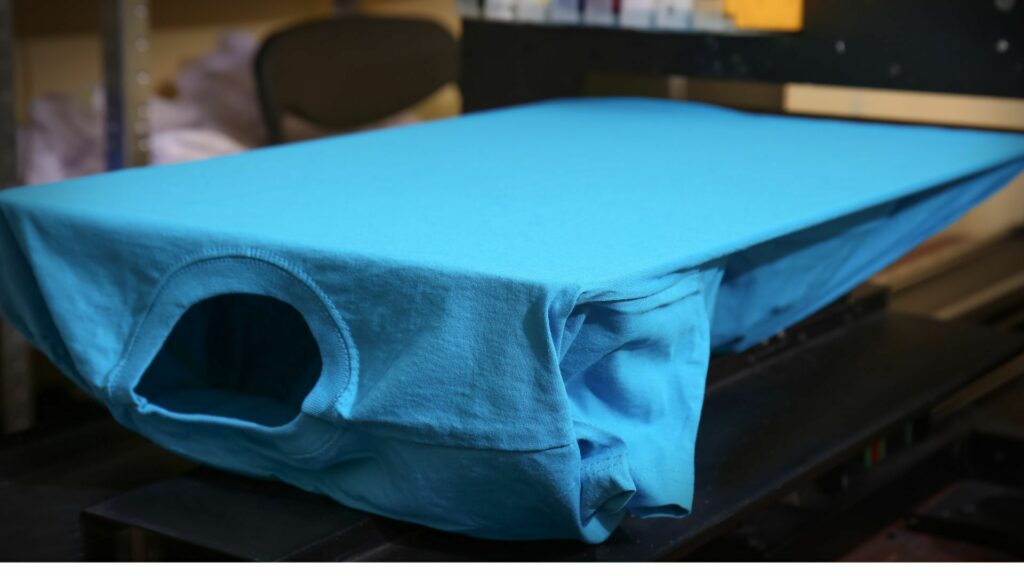
DTG printing is a digital printing method. A design is digitized so that a raster image processor (RIP) software can translate it into a set of instructions. The printer uses these instructions to print the design directly onto the garment. This is achieved by spraying ink onto the surface using carefully controlled print heads in the machine.
Benefits of DTG Printing
Digital format: DTG printing quickly digitizes various complex designs and prints them onto the garment. It can create a range of colors from only four, or sometimes six, base colors to create unique, multicolored designs.
Designs with many intricate details will significantly benefit from DTG printing and can even be customized on the fly without interrupting the whole printing process.
Minimal Setup: Once you’re ready to print, it’s as easy as printing out a document with your office desktop printer.
Small-scale Orders: Print-on-demand orders, like a batch of shirts for a school sports team, are where DTG printing shines.
Consistency: The first print will always look the same as the last one since the printing machine handles everything. An additional benefit is that the inks are sprayed onto the surface, which helps reduce a buildup of ink and improves the flexibility and airflow of the garments.
The best part is that DTG prints have the softest feel compared to screen-printed designs, which helps contributes to their popularity.
Where DTG Printing Lacks
Costly Entry Barrier: Even the most affordable printers can cost up to $16,000. We haven’t even factored in the additional costs of procuring the extra equipment needed – from pre-treatment machines to ensure the inks adhere to the surfaces used, a heat press, and the RIP software to convert the design into a set of instructions that the printer uses for printing it out.
You can purchase slightly more affordable options, but many of these are limited to specific features, such as being able to print on light garments only.
Expensive Inks: Most of the cost of DTG comes from high white ink use, especially on dark shirts. This is because color inks need to be printed on a white underbase rather than directly onto the garment to ensure the colors stand out.
Inks Aren’t Very Durable: You might find after a couple of washes, a DTG print’s ink will have started to fade. The amount of pretreatment used and the time to heat press it after printing can contribute to the durability of a print. Still, consistency can be tricky if you’re using manual methods of pretreating (i.e., using a spray gun).
Not Versatile: DTG printing is also challenging to work on many fabrics, textiles, and other materials, a problem that has persisted since DTG’s conception. Issues like dye migration, where the garment’s dye bleeds into the ink, can happen when DTG printing is used on incompatible materials.
Best for Print-on-Demand: As your orders increase, your overheads also increase exponentially. It doesn’t help that it’s slower than a screen printing setup, being able to print 15 to 20 shirts per hour. Then there’s the issue of costly inks that drive up your costs if you take on large orders.
Maintenance Blues: Regular DTG maintenance is vital as many factors affect your printer’s performance. You’ll need to be very mindful with its maintenance, or else the printer will present a myriad of problems that only end up costing you for as long as the printer is down.
Introducing Digital Hybrid Systems
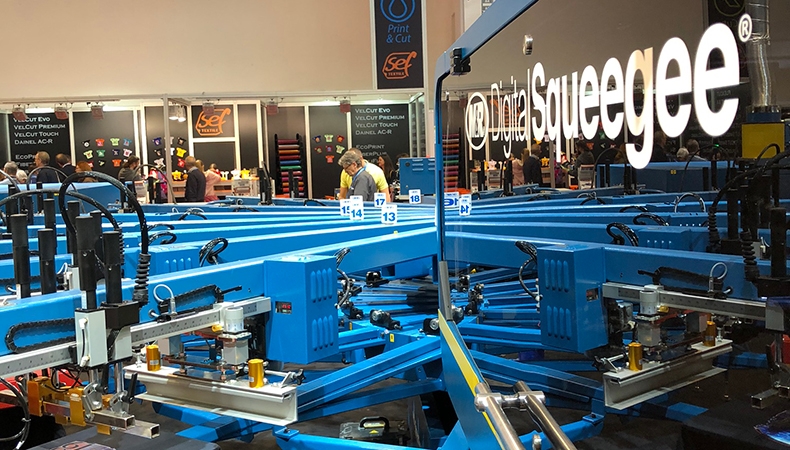
The digital hybrid is a revolutionary solution that combines screen printing and DTG printing’s strengths into one comprehensive package. It uses a screen-printed underbase, removing the need for time-consuming pretreatments to let the ink set in. It also adds the convenience of digital printing to directly print multiple colors on intricate designs.
Combine the digital hybrid printer with an automatic carousel that allows you to print garments rapidly. You’ll get an excellent, high-speed printing system that doesn’t sacrifice quality for quantity.
The Kornit Paradigm was one of the earliest digital hybrid systems introduced sometime between 2012 to 2013. Newer systems have been developed since then, with M&R Industries’ DS-4000 Digital Squeegee being one of the more central systems to hit the market in 2018.
How It Works
The premise behind the Digital Squeegee is pretty simple. You’ll place the machine in a well-ventilated space and pair it with an automatic oval (or circle) screen printing press. Once your screens are prepped and ready, you can have them set up with the automatic screen printing press.
The screens are used for two main reasons:
- Apply a white underbase that allows the inks to set into the underbase, preventing the inks from blending into the substrate.
- Add additional coats that help make the design more durable.
Once the garment reaches the printer itself, the printer applies the design on top of the underbase, followed by a bleed blocker to lock the inks and significantly improve its durability. Once you dry the garments, they’re good to go.
Where the Digital Squeegee Excels
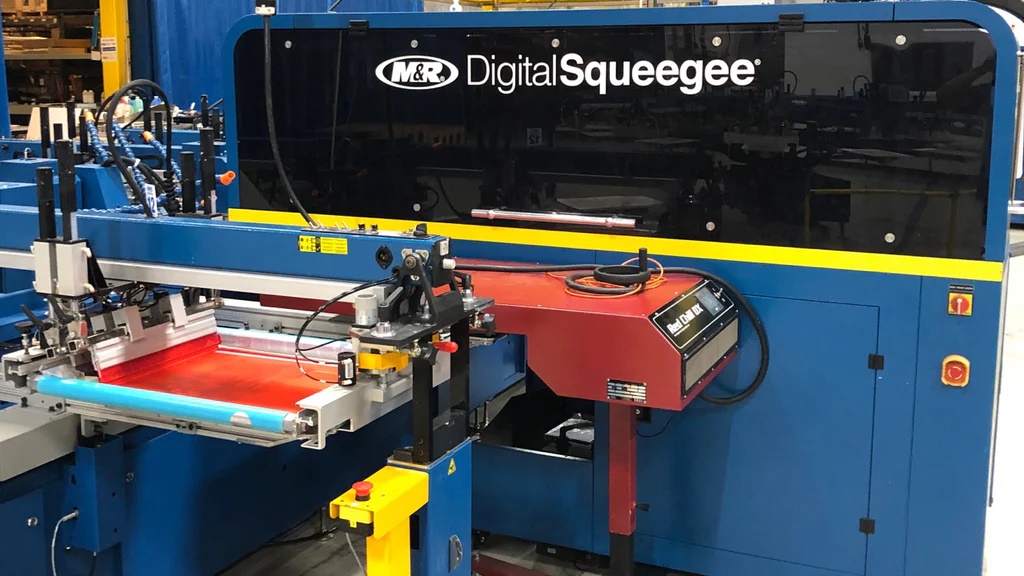
Because it seamlessly combines screen printing and DTG printing into one powerful machine, digital hybrid systems like the Digital Squeegee grant its users a significant edge in terms of adaptability and versatility.
Maximizing Profits
It might be daunting even to consider the machine when it has a hefty price tag, but that initial investment will eventually lead to more and more savings. You’ll find that you need fewer screens for high-color print runs, use less white ink for your underbase, and remove pretreatment from the printing process, among other things.
Screen printing and DTG can be time-consuming depending on the kind of designs you’re printing. DTG has an easier time with complex designs, but the time it takes to print each shirt makes it inefficient to handle bulk orders, unlike screen printing.
The Digital Squeegee can take on complex, multicolored designs at impressive speeds, allowing you to price your products at a decent premium tier and offer excellent quality that your customers will love.
Leveraging the Digital Squeegee’s abilities to their fullest can eventually help you build on your business and rake in the profits you’ve gained.
Variable Data
The Digital Squeegee’s main strength comes from its variable data printing capabilities. With variable data, you can quickly change various aspects of your design within the same print run and do all of it on the fly. Clients can easily place a single order with multiple garments printed in various colors and design schemes instead of putting a few orders with different design needs.
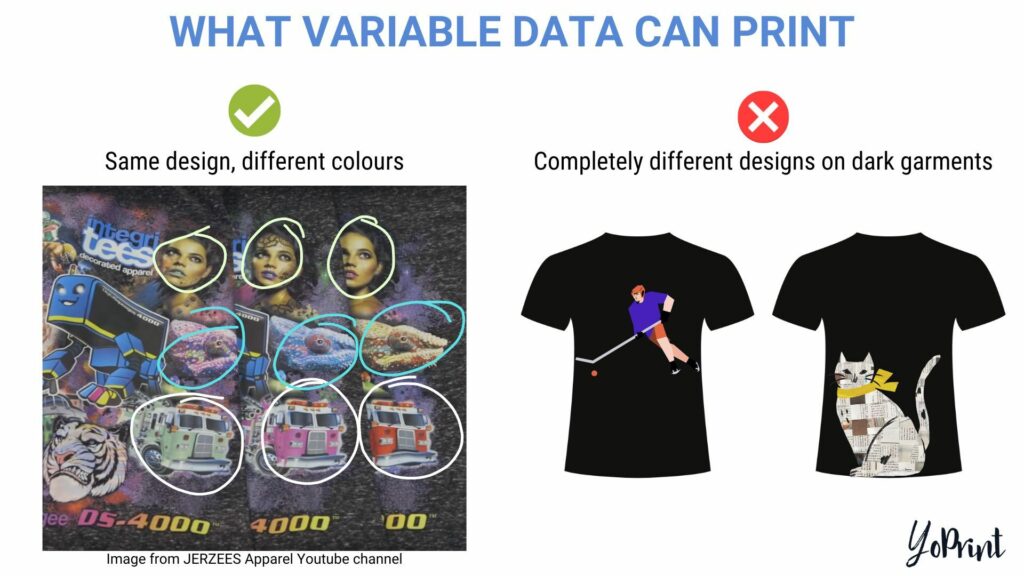
However, you won’t be able to switch from one design (say, the ones used in the image above) to a completely different one on dark garments. The Digital Squeegee requires the screen printed underbase to be the same as the design being printed.
Adding Special Effects
Usually, you’d have difficulty incorporating glitter, shimmer, or foil in your designs, depending on the substrate or the method you use to add these special effects. You’ll need to be careful with applying these special effects, or you might create a lackluster print that doesn’t stand out.
The Digital Squeegee makes it easy to add these special effects by automating the process. All you need to do is pre-apply the special effect (or apply it after printing, depending on the method), and the Digital Squeegee will do the rest.
If your client wants a few shirts of the same design, with just a few shirts in the order having special effects, the Digital Squeegee can get it done in no time flat!
Impressive Durability
While most screen or DTG printed designs have good durability when done right, the degree still varies depending on other factors such as the type of ink used, whether uniform pretreatment was applied for DTG prints, and how the print was dried. In some cases, the prints may eventually fade over time.
With the Digital Squeegee, you’ll get screen printing’s reliable durability on a digitally printed garment. The colors and prints last for a long time without losing their vibrance or details, and you also get significant washability that can last more than 50 runs in the washer.
The screened bases give the inks more resilience, owing to their thicker inks. DTG inks are generally thinner water-based inks, which easily seep into the garment without a pretreatment layer. The underbase allows the color inks to be cured appropriately and set into the garment.
Screen Printing Versatility
DTG printing is excellent, but its water-based inks make it hard to work well with specific garments such as polyester. DTG works well with cotton (and similar substrates) as the inks can easily seep into the fabric. Specific substrates like polyester, however, have waterproof properties that prevent the inks from setting in as they should.
You can still print on such difficult substrates with DTG printing by adjusting the amount of pretreatment or using special pretreatment solutions. However, the results might not always turn out as they should.
Consistency
Traditional plastisol inks are liquified plastic. Specifically, it’s thermoplastic, meaning heat can smear the ink. During a print run, high heat well above the recommended temperature can cause the inks can start to mix on the screens. You’ll end up with ugly prints.
The Digital Squeegee answers this issue by using water-based inks and the digital design process, printing the same image from start to finish without problems with color mixing or smearing.
Environmentally Friendly
Printers are doing their best to be environmentally conscious with how they run their businesses. Screen printers were primarily concerned with using plastisol inks containing phthalate plasticizers, a hazardous material that needs to be disposed of properly. Phthalate-free inks are still dangerous to the environment and people who mishandle them.
The Digital Squeegee’s inks are GOTS-certified water-based inks, free from various chemicals or additives such as CFCs and HCFCs. Cleaning up after a printing run is also much safer since the inks are water-based, ensuring that harmful substances aren’t disposed of and introduced into the local water supply.
You can rest assured that your prints are guaranteed to be environmentally safe and provide excellent all-around quality without sacrificing the wearer’s comfort.
Challenges Faced
Despite the many positives the Digital Squeegee presents to the industry, it remains a recent innovation going through growing pains. Tempting though it may be to acquire one, you’ll need to be aware of what the Digital Squeegee is limited to.
Very High Entry Cost
Printing machines such as the Digital Squeegee and the Lawson Zeus V Digital Hybrid Squeegee-Jet are a few hybrid printers available on the market. Its high price tag is the current roadblock to acquiring a machine. You’ll be looking at a price of at least $400,000 – and that’s just for the Digital Squeegee alone!
Once you add on the automatic oval/circle printing press needed to work with the Digital Squeegee, your bill will start skyrocketing. For example, an automatic oval/circle press costs between $30,000 to $150,000 or more. Meanwhile, a large conveyor dryer, for example, can cost anywhere from $15,000 to above.
If you already own some of this equipment, switching to the Digital Squeegee would be a good move as you can eliminate a significant amount from purchasing; all left is acquiring the Digital Squeegee itself.
Space Requirements
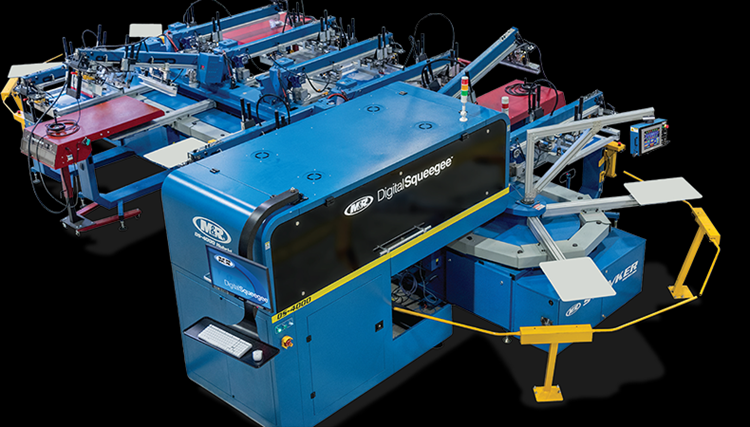
On top of the price tag, you’re buying a machine that’s 48 inches wide, 104 inches long, and 86 inches tall without the automatic press paired to it. Compare that to the size of a standard inkjet printer or your current setup of manual oval/circle screen printing presses.
Much like your other specialized equipment, you also need to make sure to place the Digital Squeegee in a proper place that is well-ventilated so that it prints all the time optimally. Dust, dirt, and other contaminants can negatively affect its performance if left to build up.
Color Matching
Though the Digital Squeegee (and other hybrid printers) tout the ability to match colors that a customer needs, this isn’t necessarily true. Current users have had issues matching a particular color that a customer needs but were ultimately forced to use screen printing to get the exact color printed.
Using your CMYK inks with a Pantone bridge can help manage customer expectations, but not all of your customers may agree with a compromise.
Significant Learning Curve
Because the Digital Squeegee is still new, it’ll take time to familiarize yourself with all the features at your disposal. Processes you and your team are used to performing in the shop will need to be tweaked and refined to match what the Digital Squeegee can print.
You’ll need to know what you can and can’t do with the Digital Squeegee. Does it leverage what you offer and do it better? How do you make full use of variable data printing? Plus, you’ll need to recalibrate your existing ICC profiles to the Digital Squeegee’s inks to get the colors you want. All these are important questions that you’ll need to devote precious time and effort to get the most out of your purchase.
What’s Next for the Digital Squeegee?
Deciding between the three options ultimately rests on what you intend for your business. You’ll have to carefully consider your business needs, your current budget allocation, and who your potential customers are. Jumping right into any of these would be disastrous if you don’t plan!
Do you have a sizeable budget but want to take on small, highly customized orders? DTG printing is a good choice, then. You’ll need to spend on the necessary equipment, but the long-term setup costs and time for printing are lower than screen printing.
You won’t be taking big orders just yet, but you can easily reach a broad audience with the ability to print intricate designs from a wide selection of colors. The quality of DTG prints, and their incredible softness, appeal to clients who want a small order of unique products that stand out.
Screen printing might be better if you have a sizeable team and a good network of potential customers. It’s much better at handling bulk orders that need a smaller but richer gamut of colors with simple designs. You won’t have the same soft feel that DTG has, but you get a lot more from each print.
The vibrant hues of screen printing inks, their ability to match custom Pantone colors used in corporate logos, and their overall durability grant screen printing staying power over DTG prints. The relatively low starting cost also allows you to quickly scale up over time as you take more orders while boosting productivity simultaneously.
Is the Digital Squeegee the Right Choice?
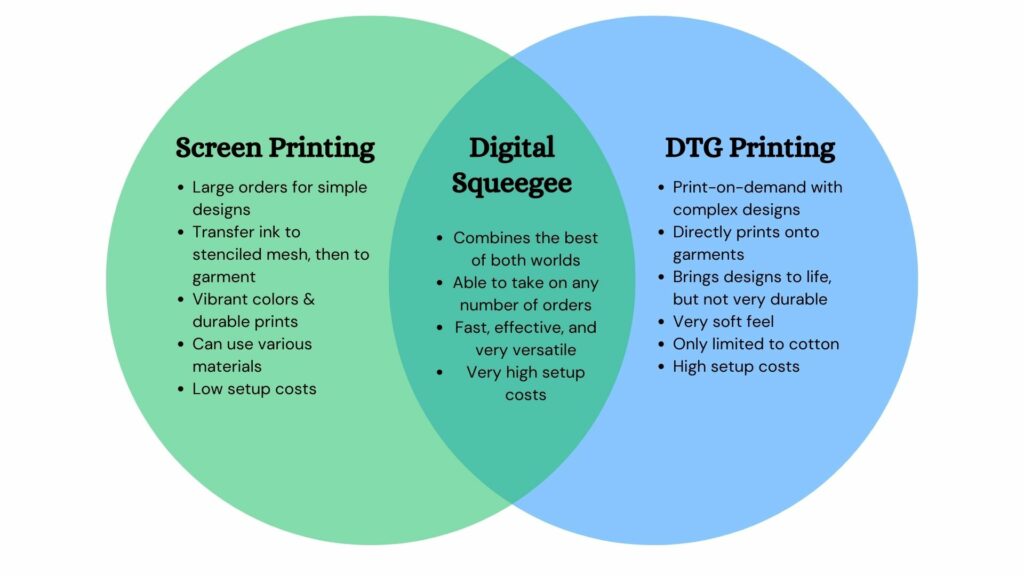
If you’re a newbie to the industry, we recommend not thinking ahead too far just yet. The Digital Squeegee is a significant hurdle to overcome. If you’ve been in the industry long and are looking for something to put you ahead of the game, then it’s worth considering.
Combining the strengths of screen printing and digital printing is a huge boon – all without sacrificing quality, color accuracy, productivity, and speed. The additional cost-saving features from combining screen and DTG printing will also become more apparent over time, and you’ll be getting your return on investment in no time. Just be sure to do your research beforehand.
You might also want to consider having a software package to help you manage your orders, monitor production, and ensure everything goes smoothly. Here at YoPrint, we can assist you with scaling your business by offering industry-leading business management tools and services. Learn more by signing up for a free 14-day trial today!
